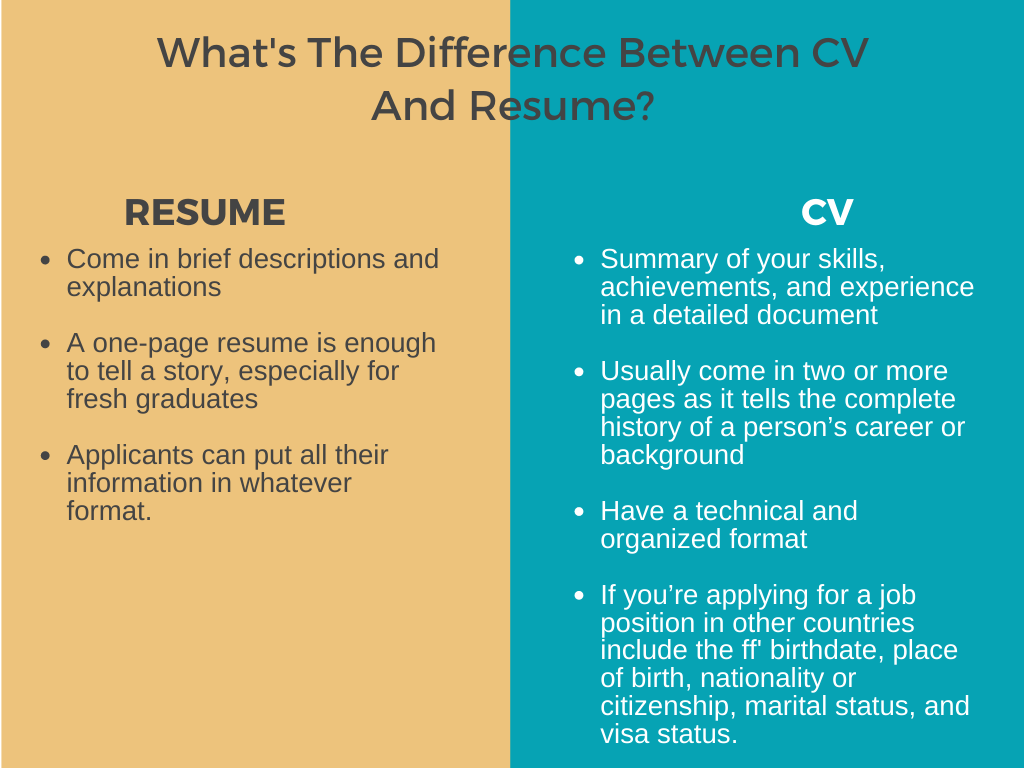Know Your Job Requirements: What’s The Difference Between Curriculum Vitae vs Resume?
If you’re entering the job market, especially as a fresh graduate, you may find yourself navigating the sometimes-murky waters of job application processes. One of the key elements of this process is compiling the right document to showcase your qualifications—either a curriculum vitae or a resume. This might seem straightforward, but understanding the difference between a curriculum vitae vs resume is crucial.
Understanding the Curriculum Vitae (CV)
A Curriculum Vitae, commonly called a CV, is a comprehensive document that provides a complete picture of your skills, achievements, experiences, and education. Unlike a resume, a CV is expansive and can extend over two or more pages, offering a detailed account of your professional history.
Key Features of a CV
-
Comprehensive Detailing: A CV includes your personal information, contact details, educational background, skills, and professional experiences. It also often encompasses additional aspects such as research work, teaching experience, publications, presentations, awards, honors, affiliations, and volunteer work.
-
Academic and International Use: CVs are not just for job applications. They are also widely used in educational settings and may be required when applying for grants, scholarships, fellowships, and teaching positions. Additionally, in many countries outside the United States, a CV may be more commonly required than a resume for job applications.
-
No Page Limit: A CV has no strict page limit, given its detailed nature. It should include all pertinent information that comprehensively covers your professional journey.
-
Structure and Uniformity: A CV maintains a technical and organized format due to the volume of information. Information is grouped under clear headings for easy navigation.
-
Personal Details: Certain personal details might also be required when applying for positions abroad. Depending on the country’s application norms, this could include your birthdate, place of birth, nationality or citizenship, marital status, and visa status.
Exploring the Resume
On the other hand, a resume is a succinct document designed to provide a snapshot of your career in a much shorter format, typically one page in length. It serves as a brief summary of your qualifications and is tailored to the job you are applying for.
Key Features of a Resume
-
Conciseness: A resume emphasizes brevity, focusing on the relevant information for the specific job application. It typically includes sections such as contact information, a professional summary or objective, work experience, education, and skills.
-
Customization: Unlike a CV, a resume can be customized for each job application. Applicants often modify the content to highlight the most pertinent experiences and skills that align with the job requirements.
-
Flexibility in Design: The resume format is more flexible. Creative professionals, such as graphic designers or multimedia artists, might incorporate colors and graphics to make their resumes stand out. However, it’s important to strike a balance between creativity and professionalism.
-
U.S. Job Market Preference: In the United States, resumes are preferred for most industries, especially in the private sector. They are designed to quickly convey skills and experiences to hiring managers with limited time.
Curriculum Vitae vs Resume: Which One Should You Use?

The choice between a curriculum vitae vs resume often depends on several factors:
-
Industry Norms: Consider what the standard is in your industry or field. Academia and research positions typically require CVs, while most other sectors prefer resumes.
-
Geographical Preferences: Different countries have varying norms for job applications. CVs are more commonly used than resumes in Europe, the Middle East, Africa, and Asia.
-
Application Instructions: Always adhere to the specific requirements of the job posting. If a resume is requested, ensure it is succinct and tailored to the job. Conversely, if a CV is called for, include comprehensive details.
-
Your Career Stage: A resume might be sufficient for early career professionals or fresh graduates as it highlights potential and training over extensive experience. But as you gain more experience, your CV will grow and become more relevant.
Bottom Line
The question of curriculum vitae vs resume ultimately boils down to what the employer prefers and the role you aim for. Contact the hiring manager for clarification if you are unclear about what to submit. But if the decision is left to you, evaluate your professional experiences and the specifics of the job description and adapt your document accordingly.
In essence, mastering the curriculum vitae vs resume debate involves more than knowing what each document contains. It requires understanding their strategic use, adapting to industry standards, and aligning with your target job market. With this knowledge, you can confidently present your professional history most effectively.
When preparing your application materials, it’s also worth considering platforms like Rakuboss, a freelance marketplace that connects talented professionals with potential employers. By showcasing your CV or resume on Rakuboss, you can highlight your skills and experiences to a broad audience, increasing your chances of landing the right job or freelance opportunity. Such platforms not only help you network with industry leaders but also offer valuable insights into how you can further refine your professional documents for better impact






